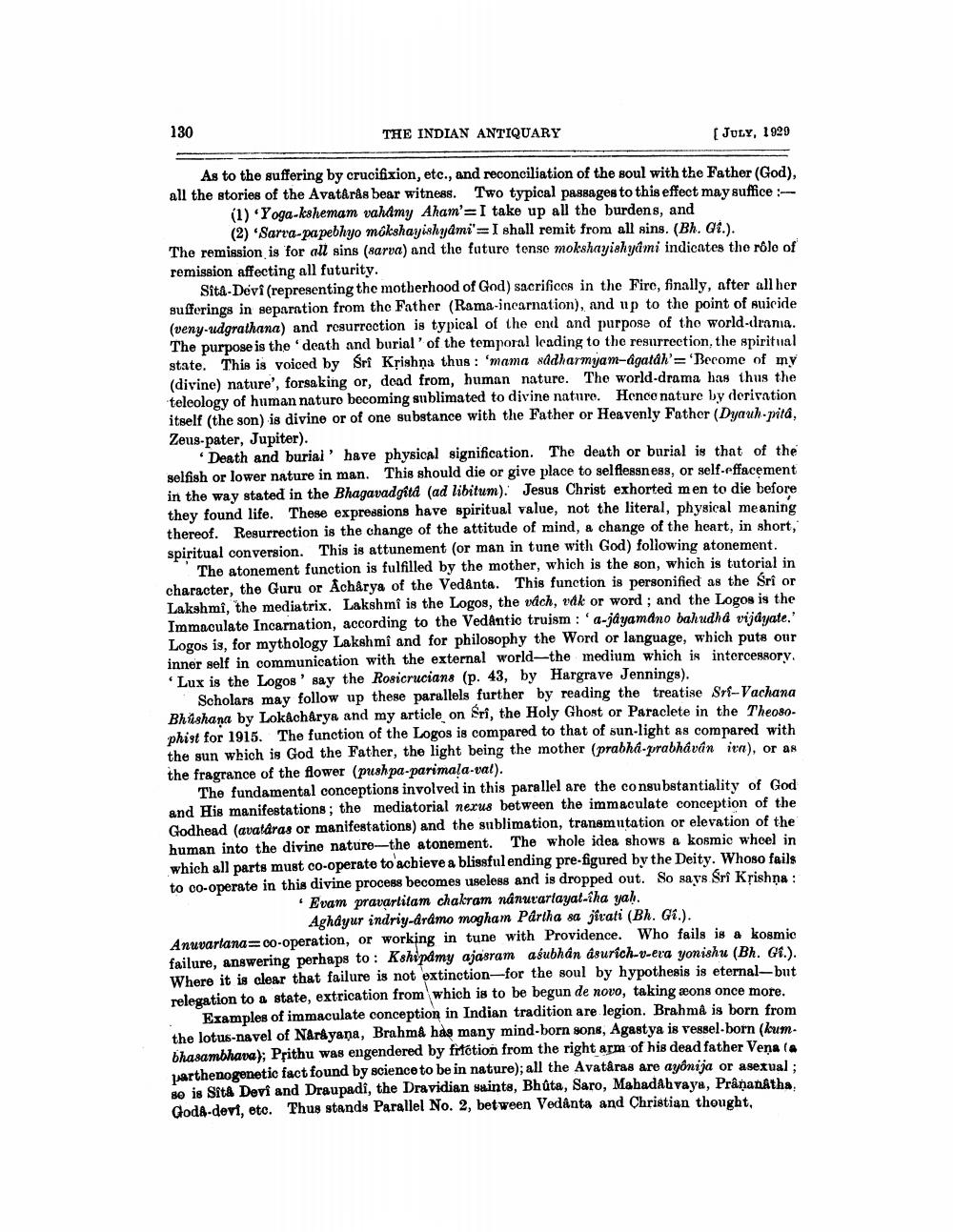________________
130
THE INDIAN ANTIQUARY
(JULY, 1929
As to the suffering by crucifixion, etc., and reconciliation of the soul with the Father (God), all the stories of the Avatards bear witness. Two typical passages to this effect may suffice :
(1) Yoga-kshemam vahámy Aham'=I take up all the burdens, and
(2) Sarva-papebhyo mākshayishydmi"=I shall remit from all sins. (Bh. Qi.). The remission is for all sins (sarva) and the futuro tenso mokshayishyami indicates the role of remission affecting all futurity.
Sita-Devi (representing the motherhood of God) sacrifices in the Fire, finally, after all her sufferings in separation from the Father (Rama-incarnation), and up to the point of suicide (veny-udgrathana) and resurrection is typical of the end and purpose of the world-Urania. The purpose is the death and burial' of the temporal leading to the resurrection, the spiritual state. This is voiced by Sri Krishna thus : 'mama sadharmyam-agatah'='Become of my (divine) nature', forsaking or, doad from, human nature. The world-drama has thus the teleology of human naturo becoming sublimated to divine nature. Hence nature by derivation itself (the son) is divine or of one substance with the Father or Heavenly Father (Dyauh-mita. Zeus-pater, Jupiter).
Death and buriai' have physical signification. The death or burial is that of the selfish or lower nature in man. This should die or give place to selflessness, or self-effacement in the way stated in the Bhagavadgita (ad libitum). Jesus Christ exhorted men to die before they found life. These expressions have spiritual value, not the literal, physical meaning thereof. Resurrection is the change of the attitude of mind, a change of the heart, in short, spiritual conversion. This is attunement (or man in tune with God) following atonement.
The atonement function is fulfilled by the mother, which is the son, which is tutorial in character, the Guru or Acharya of the Vedanta. This function is personified as the Sri or Lakshmi, the mediatrix. Lakshmi is the Logos, the vách, vák or word; and the Logos is the Immaculate Incarnation, according to the VedAntic truism :'a-jayamano bahudhd vijayate,' Logos is, for mythology Lakshmi and for philosophy the Word or language, which puts our inner self in communication with the external world—the medium which is intercessory. 'Lux is the Logos' say the Rosicrucians (p. 43, by Hargrave Jennings).
Scholars may follow up these parallels further by reading the treatise Sri-Vachana Bhishana by Lokâcharya and my article on Sri, the Holy Ghost or Paraclete in the Theosophist for 1915. The function of the Logos is compared to that of sun-light as compared with the sun which is God the Father, the light being the mother (prabha-prabháván ita), or as the fragrance of the flower (pushpa-parimala-val).
The fundamental conceptions involved in this parallel are the consubstantiality of God and His manifestations; the mediatorial nerus between the immaculate conception of the Godhead (avaldras or manifestations) and the sublimation, transmutation or elevation of the human into the divine nature-the atonement. The whole idea shows a kosmic wheel in which all parts must co-operate to achieve a blissful ending pre-figured by the Deity. Whoso fails to co-operate in this divine process becomes useless and is dropped out. So says Sri Krishna :
Evam pravartitam chakram nánurarlayat-îha yah.
Aghdyur indriy-drdmo mogham Partha sa jirati (Bh. Gi.). Anuvarlana=00-operation, or working in tune with Providence. Who fails is a kosmic failure, answering perhaps to: Kshipdmy ajasram aśubhán asurich-v-era yonishu (Bh. Gi.). Where it is clear that failure is not extinction-for the soul by hypothesis is eternal-but relegation to a state, extrication from which is to be begun de novo, taking æons once more.
Examples of immaculate conception in Indian tradition are legion. BrahmA is born from the lotus-navel of Narayana, Brahmå has many mind-born sons, Agastya is vessel-born (kum. bhasambhava); Prithu was engendered by friction from the right arm of his dead father Vena (a warthenogenetic fact found by science to be in nature); all the Avatāras are ayônija or asexual; so is Sita Devi and Draupadi, the Dravidian saints, Bhůta, Saro, MahadAhvaya, Pránanatha GodA-devi, oto. Thus stands Parallel No. 2, between Vedanta and Christian thought,




